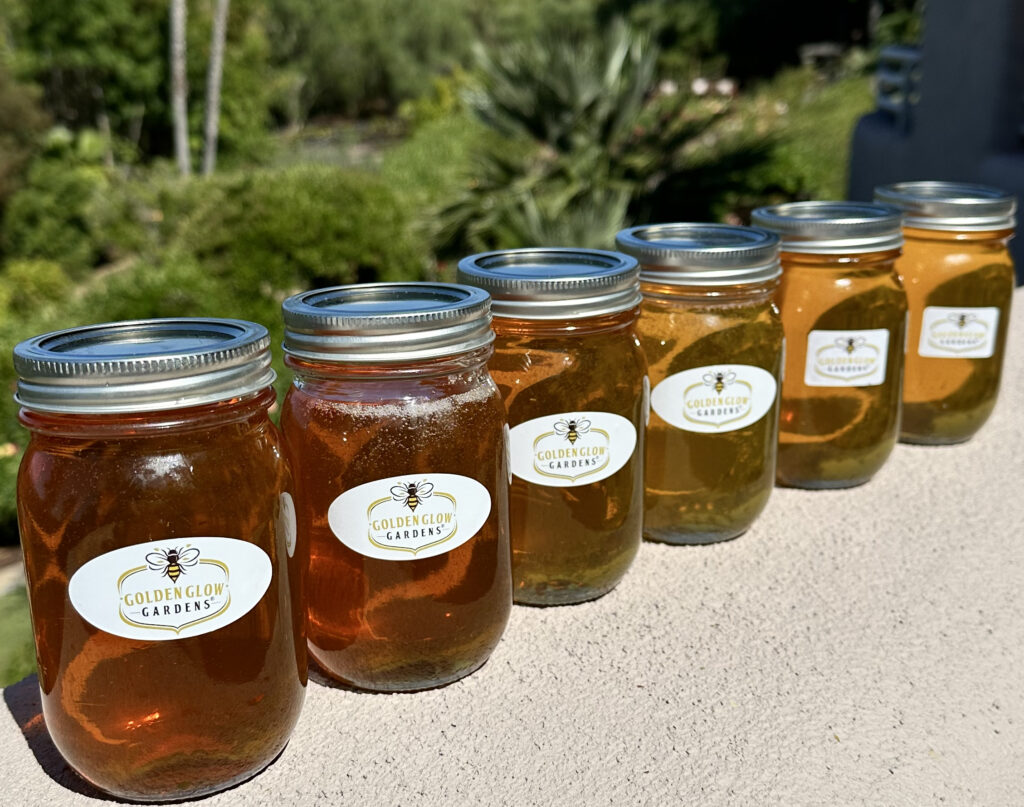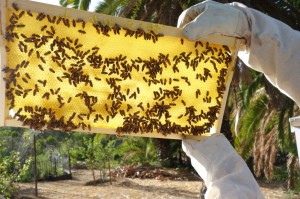June 21, 2024

In 2023, my attempts to harvest honey from my flow hive supers and my full flow hive was a disaster. The problem was the honey didn’t flow toward the back because the hive was too level. After you’ve fractured the honey frames by turning your long, metal, key tool, gravity will cause the honey to simply – and disastrously – pool in the bottom of the hive, rather than flow along the tube to the back where you can collect it. This can cause your bees to drown, which I think happened to me last year. It took a year to fully resuscitate all my hives and is why I didn’t make any more attempts in 2023 to collect any honey.
The two flow hive honey supers that were on top of traditional 10-frame brood boxes couldn’t easily be lifted in the front to allow the honey to flow out the back. When I tried to lift them up a little in the front, the bees in the brood box were very upset and let me know! They streamed out and made collecting the honey very difficult.
My full flow hive (upper and lower boxes) was supposed to be easily adjustable to lift the front. Even with the little level visible in the window, the screws on the legs were too hard to turn under the weight of the flow hive to tilt the front upward to allow flow toward the back.

Here is an image shared by another flow hive owner showing his honey pooling disaster. My hands were too full managing the problem to take photos myself, but this is the problem I wanted to solve in 2024. And did! Hurray!!
I bought two (they come as a set of 2) inexpensive “arm lift jacks” on Amazon. Here is what the two jacks look like as I used them to slightly lift the front of my flow hive.
Thanks to these jacks, it couldn’t have been easier – or more successful – to lift the front of the entire hive, not disturbing the bees, and let the honey flow to the back where I collected it. You can also see one of the backs visible at the front of the hive, from the side, toward the end of my video showing the honey flowing nicely out the back.

January 23rd. That’s a record for early honey draw at Golden Glow Gardens. No doubt the three capped frames in Hive One’s honey super were a result of having left the bees alone ever since we did a 1-2 frame draw in Spring 2021 and the bees were then robbed of all the rest of their stores.
Looking into the side window I was met with a welcome sight of tons of bees working to fill and cap the outermost frame. There were so many bees, I couldn’t see past them to check how much of this frame was capped.

I caught glimpses of glistening in some cells which tells me the cells are filling with honey, but not yet capped. I’ll definitely leave this frame for the bees to keep working on.
Here is a picture of the honey frames I’m going to harvest seen from the Flow Hive’s back window.

The honey had overwintered and was dark reddish amber in color and delicious with a richness of flavor different from the light spring honey I expect we’ll be drawing in a few months. Can’t wait to see what the bees refill these frames with to compare.

This time, I took two frames of honey and I’ll be keeping vigil closely over the next few days to be sure no robbing takes place.
I believe the reason robbing is more common after a flow hive draw is that honey leaks and pools at the bottom of the honey hive after the draw. Until this gets cleaned up by the bees, it attracts predators.
Speaking of which, during my flow hive inspection, I noticed a lot of ants. While ants aren’t supposed to be harmful to a healthy hive, I am going back to the apiary tomorrow and coating the legs of the bee stand with tanglefoot to keep ants from climbing from the ground to the hives.
This weekend, I also spread diamataceous earth around the base of the bee stand. That also should help keep ants at bay. My original purpose of spreading the diamataceous earth was to repel hive beetles, but all the better if it serves two purposes.
We enlist the expert help of Hilary Kearney to watch our hives and harvest our honey as we aren’t in Southern California very often. She is wonderful, super knowledgeable, and can be a great resource for anyone needing help with bees in San Diego area or just with information in general. She runs classes, writes an excellent blog, and has a good instagram account. Check out Girl Next Door Honey!
We checked our two hives on June 21st and found they were both doing very well. Interestingly, our left hive has surpassed the right one in status even though we established this hive about 3 weeks after the right hive. There are more capped honey frames filled in the left hive than the right. We also notice more bees in the top honey super on the left than the right. Also, the bees in the left hive drink their sugar-water supplementation about three times as fast as the bees in the right hive

showing the golden honey in the sun
We’re not sure if it’s the reason why the left hive is more robust and is growing faster, but the bees in the left hive are also much more aggressive than the bees on the right. Could they have a touch of Africanism, we wonder?
More photos of the honey build up in the top supers of our hives: 





Last year, we had not even rescued our first hives of bees by Memorial Day. This year, we added two new hives and got them early in the season (February in California). We’ve also been feeding both hives steadily with 1:1 sugar:water syrup, and prior to when we added the honey supers, we also fed the hives Pro-Bee cakes. Our hope is that these two factors will allow us to take one small draw of honey prior to the fall.
Today, we decided to reward ourselves with a first taste of honey. Our bees have been busily filling the honey supers (two medium on each hive) with honey. It’s still too early to do a full honey draw because the honey isn’t full in either super, nor is it capped. But in inspecting the hives today, hive 1 had several pieces of comb that the bees had built up between frames. For hive maintenance – and conveniently to collect some honey – we removed the extra comb.
I had brought a large metal bowl down to the honey grove just in case such a situation presented itself. Of course many bees came with the comb into the bowl, but we gently and patiently brushed them off the comb, and back into the hive, leaving us with beautiful comb dripping with honey. Rand showed me that I could chew on the comb, much like chewing gum. What a pleasure! Our honey is indescribably sweet and flavorful. I can’t wait to do a proper draw and share it with our friends and family!
Of course many bees came with the comb into the bowl, but we gently and patiently brushed them off the comb, and back into the hive, leaving us with beautiful comb dripping with honey. Rand showed me that I could chew on the comb, much like chewing gum. What a pleasure! Our honey is indescribably sweet and flavorful. I can’t wait to do a proper draw and share it with our friends and family!
bees on the honey super’s frames: